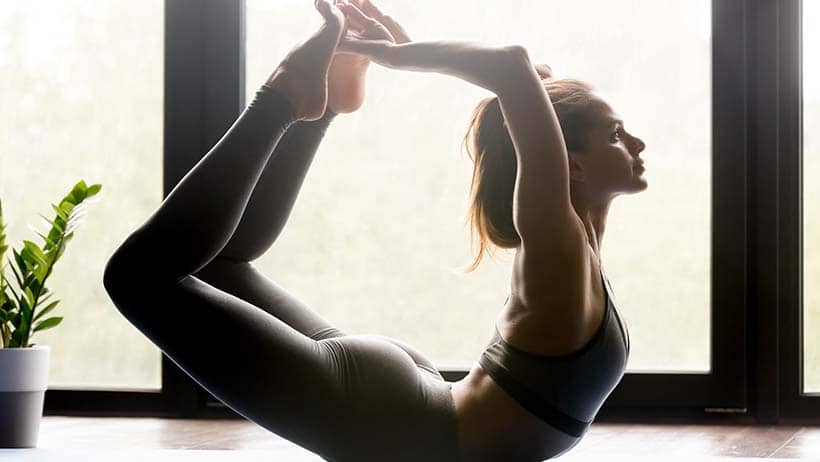
Every yoga pose, known in Sanskrit as an “asana,” has its own way of bringing the body and mind into greater harmony. World-renowned yoga teacher B.K.S. Iyengar poetically compares the body to a bow and each asana to the various arrows with which individuals target the ultimate aim of yoga practice — the soul.
About the Pose
धनुरासन
Dhanurasana
“Dhanur” translates to “bow” in Sanskrit, and an archer’s bow is the shape your body will take when practicing this pose. Dhanurasana will stretch all parts of your back. Backbends like this pose are essential for the modern American whose posture seems to drag them down. Practicing dhanurasana and other chest-opening, spine-stretching poses can enhance the way you carry yourself so you can really let your inner light shine.
Level: Beginner
Key Benefits:
- Strengthens the spine
- Stretches the ankles, calves, and thighs
- Massages the digestive organs
- Expands the chest
Specific Cautions:
- Pregnant or menstruating women should avoid this pose.
- Dhanurasana is not the best pose to practice during a headache or migraine.
- People with neck or back injuries should use caution when practicing this pose. Those with a neck injury also should keep their head level and avoid looking upward.
- People experiencing diarrhea, irritable bowel syndrome (IBS), or any related symptoms also should avoid this pose.
Related Poses:
- Boat Pose (Navasana): This intermediate pose engages the core and strengthens the hip flexors.
- Camel Pose (Ustrasana): This beginner pose improves posture, relieves back and shoulder stiffness, and increases lung capacity.
- Bridge Pose (Setu Bandha Sarvangasana): This beginner pose encourages flexibility in the spine and shoulders, improves digestion, and expands the chest.
Recommended: Browse more of our guides on the art and practice of yoga to harmonize your body, mind, and soul.
Trying It Out
Remember to keep your breathing full and steady as you follow these step-by-step instructions to try this pose out for yourself:
Step One
Lying on your belly, rest your chin on the floor. Bend your knees and reach your hands back so they can grab your ankles. Relax your feet.
Step Two
Inhale and arch your body upward. Your head, chest, and thighs should lift up off the floor. Stretch your feet as high and as far away from your body as possible.
Step Three
To lift your chest higher, keep your head back and your eyes looking upward.
Step Four
Breathe and hold this pose for about 10 seconds.
Refining the Pose
Achieving maximum benefit from your yoga practice requires you to pay close attention to your physical alignment. To ensure you maintain proper alignment, ask yourself these questions:
- Are you breathing normally?
- Are your thighs parallel to each other?
- Are your feet relaxed?
- Are your elbows straight?
- Are your legs and arms firm so as not to damage your spine with excess weight?
Variations:
- Rocking Bow Pose (Dhanurasana Rocking Variation): This variation employs a rocking movement after you move into the normal bow pose. With your head back and eyes looking forward, use your breathing to rock your body slowly back and forth. Rock your body backward with each inhale and rock your body forward with each exhale.
- Side Bow Pose (Parsva Dhanurasana): This variation involves the addition of rolling onto your right side to pull your chest forward and your legs back. Resume the normal bow pose and then practice the same stretch on the left side of your body.
- Half Bow Pose (Ardha Dhanurasana): This variation takes a gentler approach to this kind of backstretch. Start by resting on your stomach, and then reach your left hand back to grab the ankle of your right foot. Inhale and raise your right leg upward. Your head and chest also should start to lift off the floor. Press your right arm firmly into the floor for support and keep your head up.
- Upward Bow Pose (Urdhva Dhanurasana): This intermediate/advanced pose stretches out the back, tones the spine, helps to alleviate the pain of menstrual cramps, and generally strengthens the abdominal and pelvic regions.